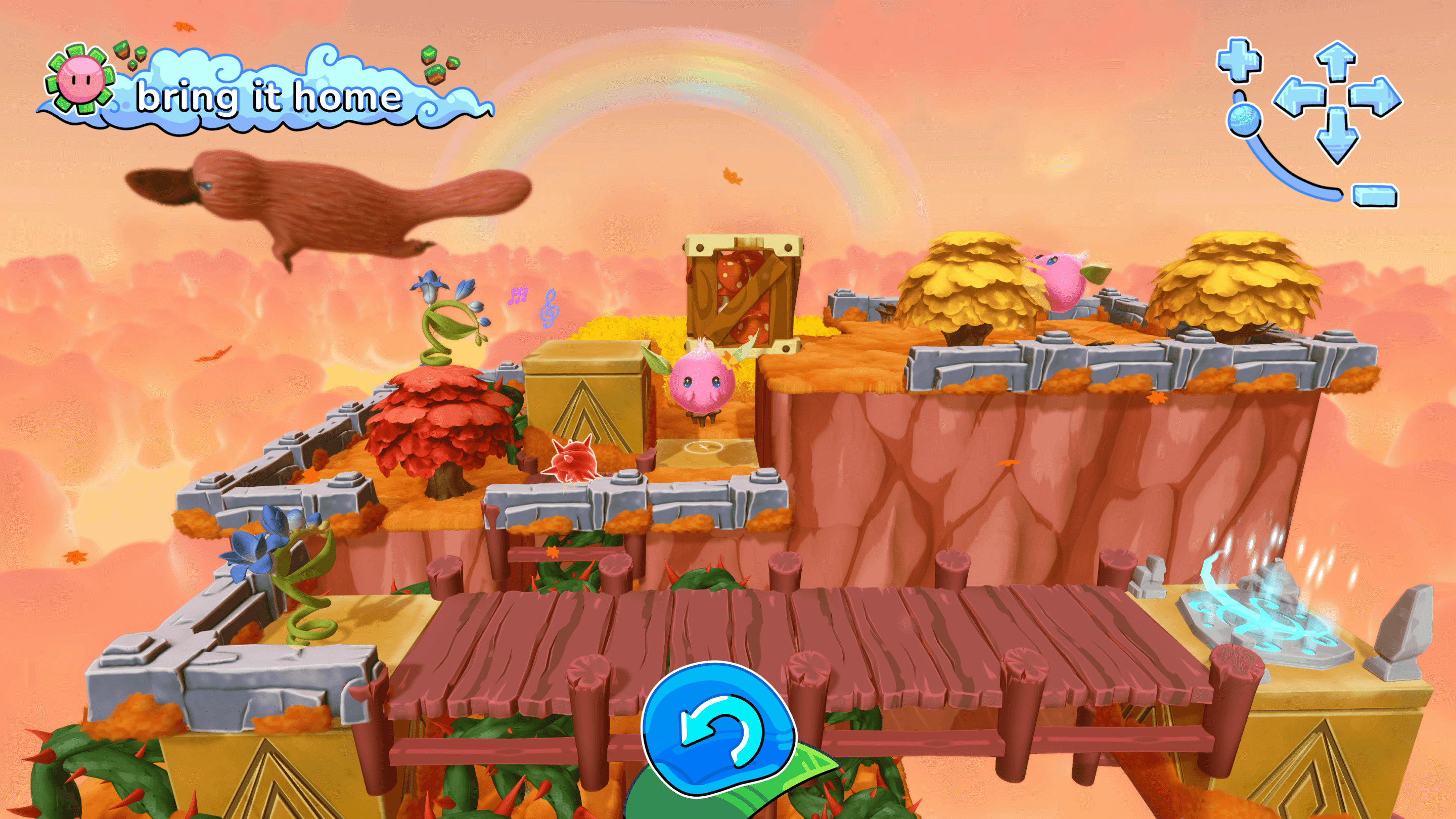Platforms:
Xbox One, PC, Nintendo Switch, Xbox Series X|S
Released:
April 17, 2025
Publisher:
Cult Games
Developer:
Witch Beam
Following the beloved Australian indie darling Unpacking, Witch Beam’s newest game Tempopo feels comfortably familiar, yet radically different. Like Unpacking, Tempopo features cozy aesthetics and approachable gameplay, but differs with its focus on jovial puzzle solving and a far more vibrant attitude.
Tempopo is a fun and exciting adventure that brings a brilliant bubbly energy to the table. Its efficient simplicity makes the game easy to understand, and the puzzles are very satisfying to resolve. However, its straightforward nature also feels like a limitation. In many ways, Tempopo is too simplistic, failing to bring interesting elements to stand out from other puzzle games. Combined with several smaller design issues, Tempopo doesn’t quite reach the ideal puzzler experience.

A Tempopo for all seasons
Tempopo places players in the shoes of Hana, a young fairy who conducts musical flowers to create harmonious melodies. When disaster strikes, Hana and the Tempopo (adorable pink blobs) must collect the flowers scattered across several blocky sky islands. Hana’s flower quest is simplistic, yet frames gameplay effectively while making flower collecting surprisingly rewarding.
Hana collects flowers by conducting the Tempopo through these islands. Tempopo move automatically to the beat, but the player can guide the Tempopo by placing powerups on the level. Abilities see Tempopo change direction, break and kick blocks, or even transform into fans and cubes.
Tempopo’s biggest strength is its simplistic design. It’s incredibly easy to get a feel for how the abilities work and where to use them. The game does a lovely job of easing you into each puzzle, letting you toy with the mechanics in smaller spaces. An Adventure Mode is also included, which restricts where the player can place powers to reduce difficulty. These features, combined with the adorable graphics, make Tempopo a great game to share with young children. Puzzles are also easy to grasp, thanks to Tempopo’s accessibility. It’s been built from the ground up to appeal to many players, thanks to basic two-button controls and clever visual design. I’m quite fond of the hint feature, which nudges players in the right direction without solving the entire puzzle.

Tempopo boasts joyous visuals, with every level bathed in a vibrant natural colour palette. Animations sync up to the musical beat, which is a great touch for such a rhythmic game. Just when the visuals start to feel samey, Tempopo will throw a seasonal change in the mix, redecorating levels with snow, or a moonlight glow.
As the later stages got more complex, I struggled with reading the more layered levels. At times, Tempopo crams lots of information into a very small space, while expecting you to track several moving elements. There are a few times where trying to comprehend how the level layout works is more difficult than the puzzle itself. It’s a bit much, and I wish these levels found a way to be more spaced out.
As you’d expect from such a musical game, Tempopo is very kind to the ears. Levels are accompanied by warm, soothing melodies, which are perfect background noise as you untangle each puzzle. When you march the Tempopo, music explodes into an energetic fanfare, which makes puzzle-solving all the more rewarding.

Seasonal changes also bring new flowers, each mimicking a different instrument. The player plants collected flowers in Hana’s garden, where they hum various notes depending on their placement. Each season ends with a sequence where the flowers sing together, a great way to cap off the world. It’s especially commendable how the sequence harmonises while adhering to wherever the player has planted their flowers.
While the presentation is mostly exceptional, the lack of features designed to deal with complex levels is frustrating. It’s easy to lose the placement of Tempopo or enemies with all the walls. The game fares slightly better with flowers by highlighting them through blocks, but it’s so subtle that it’s still easy to lose their location. Additionally, flowers don’t stand out enough within these nature-heavy environments, which is annoying when they’re vital to finishing levels.
Perhaps the worst offender is the camera, which always anchors to the exact centre of every level. While the player can zoom and rotate the camera, frankly, it’s not enough control for the jagged formation of later levels. I understand Witch Beam wants to keep controls simplistic, but this decision sacrifices visual clarity. There are several levels where I can’t get an ideal perspective, or struggle to follow the marching Tempopo due to awkward angles.

Gardens of Mischief and Melody
The puzzles of Tempopo start off very basic, and take quite a while to become interesting, as the difficulty curve intends to ease players in. It definitely achieves this, but it also means a fair chunk of levels goes by too quickly without much thought. Once things pick up, there’s a consistent quality to every level, which rides all the way to the finale. The later levels are very rewarding to solve, especially as Tempopo continually delivers small twists on existing powers.
The difficulty in these later levels feels fair yet challenging. I’d have to stop and think for a while in the game’s second half, although there’d still be a strangely easy level on occasion. Difficulty is subjective, and your mileage may vary, but I appreciate that the later worlds were able to challenge me without feeling overly frustrating. However, one particular issue that kept propping up is how some blocks are clearly telegraphed for powers. I wish the visual clues had remained in the game’s restrictive adventure mode, as it limits experimentation and highlights the solution very quickly.
“Once things pick up, there’s a consistent quality to every level, which rides all the way to the finale.”
The powers are fun to play with. Abilities initially seem one dimensional, but Tempopo gets lots of mileage from these abilities as level complexity grows. I do wish there were one or two new powers through the adventure, as using the same abilities from beginning to end does get pretty repetitive. This repetition is compounded by how little the directional power is used. While it’s the least flashy ability, there’s a lot of untapped potential with changing the direction of the Tempopo mid-march.
Pacing-wise, Tempopo is on the shorter side, but it’s a decent length given the limited variety. The main story, consisting of 60 puzzles, took me just over four hours to finish. While the lack of gameplay changes was starting to weigh down the experience, the short length prevented this from becoming a major issue. Thankfully, the game also provides a bonus challenge mode for those who really crave more Tempopo.
Despite its short length, I do wish Tempopo had introduced a couple of surprises into the mix. You’ve seen every mechanic within the game’s first ten levels. It’s not just Tempopo powers; hazards and enemies remain static through the entire journey. While the season changes are aesthetically pleasing, it’s a massive missed opportunity not to alter mechanics or even level design with each season.

Unfortunately, Tempopo’s puzzles also suffer from some glitchy interactions. There were several puzzles where one of my Tempopo would remain as a cube indefinitely after transforming. I found no way to resolve or reduce this issue, beyond resetting the level and sometimes the entire game. Even when cubes are functional, I experienced other bizarre side effects, such as Tempopo turning invisible for the rest of the level.
One especially aggravating experience involved a fan power-up that always ended a couple of beats early. I spent an incredibly long time on this puzzle, trying different solutions, only to give up and use hints. It was then that the game told me my first solution was correct, but even after recreating it, the fan simply wouldn’t stay long enough. Restarting my game fixed the issue, but it was incredibly frustrating to see the game completely fail on me. To Tempopo’s credit, these glitches were infrequent, but the several puzzles they appeared in were always a hassle.
Between the glitches and camera struggles, I found myself replaying level solutions frequently. This highlighted how repetitive the marching sequences become when experimenting with complex solutions. Some extra features could’ve been included to alleviate this. It would’ve been nice to have some sort of “onion skinning” feature, where the game shows a Tempopo’s position on each beat of the song before playing. I also think it should provide some visual indicator for exactly how long a cube or fan transformation is supposed to last.
A more simplistic solution would be a double-speed toggle to move past the early stages of a march that you’ll see dozens of times. It’s possible these features were excluded to maintain a simplistic design, but their absence emphasised how repetitive the marching sequences get, especially on the very large levels. As Tempopo requires remembering the location of friends and foes on every beat, it should provide some features to help track this information.

To round out the package, Tempopo features some extra game modes that unlock as you progress. The Melody Garden is unrestricted, allowing you to place way more flowers in a larger environment, with finer control. It’s a great inclusion, especially for those who love Tempopo’s soundscape, or want to experiment with creating music. The openness of the Melody Garden allows you to create all kinds of melodies. Or, if you’re like me, an abomination of sound that runs at 480 BPM.
As for the challenge mode, I tried several levels and left pretty impressed with the package. Including an additional 60 levels after the main story is a massive feat that certainly makes Tempopo all the more worthwhile. These levels introduce even more complicated scenarios for the existing powers. Keeping these separated from the main campaign is a smart decision, although with the continual lack of new mechanics, I don’t expect this mode to captivate everyone.
Ultimately, this is a very good package of puzzles presented beautifully. Tempopo is a great puzzle game to get younger or inexperienced audiences into gaming, or someone looking for a light and fun experience. But the puzzles in Tempopo aren’t quite engaging or diverse enough to make it stand out in the crowded genre.
7
Good
Positive:
- Simplistic & accessible puzzle design
- Charming graphics that sync to the music
- Energetic music that brings each season to life
Negative:
- Lacking mechanical variety in later levels
- Some levels are too big and visually cluttered
- Glitches that halt progression
Tempopo is a heartwarming little adventure that brings so much energy with its clever gameplay and charming visuals. Watching the little creatures successfully march as you solve each level is always satisfying. The straightforward mechanics in Tempopo ensure a very approachable experience for younger or inexperienced audiences. However, there are too many areas where it feels too simplistic, and lacks the polish to stand out as an exceptional puzzle game.





